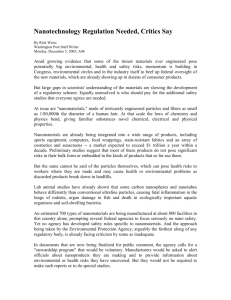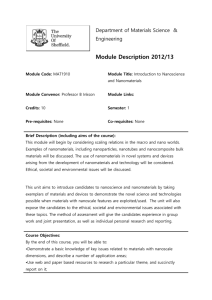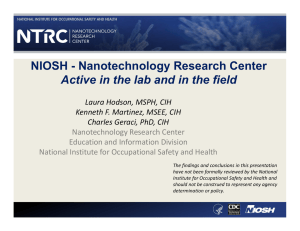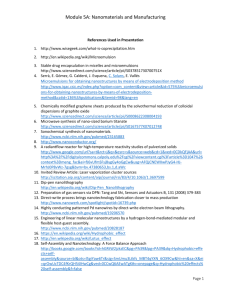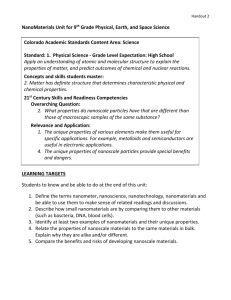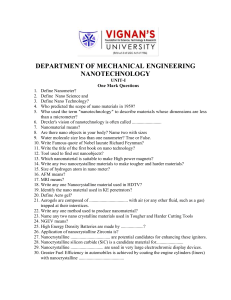Building a Risk Management Program for Nanomaterials
advertisement
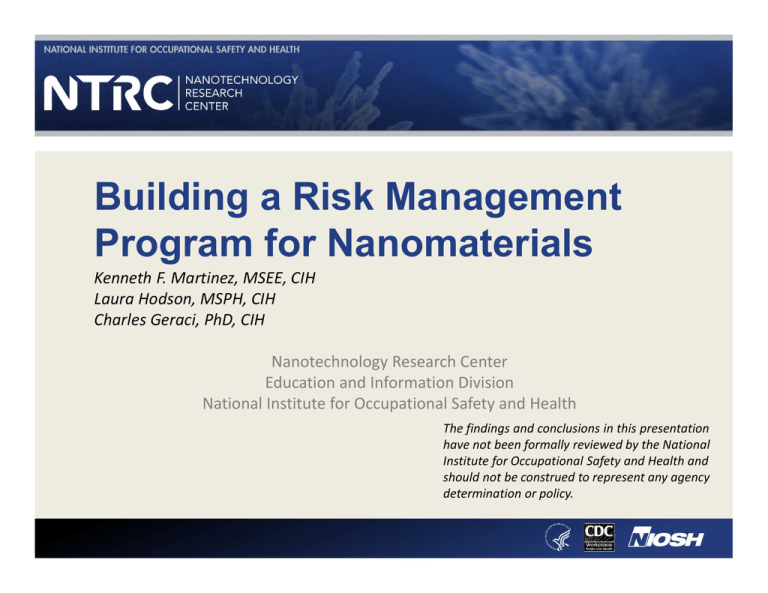
Building a Risk Management Program for Nanomaterials Kenneth F. Martinez, MSEE, CIH Laura Hodson, MSPH, CIH Charles Geraci, PhD, CIH Nanotechnology Research Center Education and Information Division National Institute for Occupational Safety and Health The findings and conclusions in this presentation have not been formally reviewed by the National Institute for Occupational Safety and Health and should not be construed to represent any agency determination or policy. Nanotechnology • Illustrates the challenges to society of a new technology – Beneficial properties – Potential hazard – What to do when information is lacking or uncertain Exposure • Workers generally the first people in society exposed to a new technology • Nanotechnology is not an exception • More than 1,000 nano‐enabled products in commerce • Workers make and use them Transport Research Laboratories Academic Commercial Warehousing/Maintenance Waste Handling Start Up/Scale Up Operations Transport Warehousing/Maintenance Manufacturing/Production Warehousing/Maintenance Transport Waste Handling Incorporation in Products Maintenance of Products Manipulation of Products Application of Products ‐ Medical Delivery Disposal / End of Life Recycling Nanotechnology • Development of materials at the atomic, molecular, or macromolecular levels with at least one dimension in the range of 1‐100 nanometers • Creating and using structures, devices, and systems that have novel properties and functions because of their small and/or intermediate size • Ability to control or manipulate matter on the atomic scale Nanomaterials • 1 ‐100 nanometer size • Special properties • Naturally occurring (incidental) and specifically engineered How little is “nano?” If the diameter of the Earth represented 1 meter… …1 nanometer would be the size of a dime. Size of Nanoparticles Relative to Microorganisms and Cells Influenza virus 75‐100 nm Tuberculosis bacteria 2,000 nm Red blood cells 8,000 nm Not only smaller, but different Same Properties 60 nm bar New Properties 30 nm bar • • • • Lower melting point Useful as catalyst Different color Different conductivity Nanoparticles: They have been around a while. Particles < 100 nm, Natural and Anthropogenic Sources Anthropogenic Natural Incidental Engineered Forest Fires Combustion engines Controlled size and shape Volcanoes Incinerators Semiconductors, carbon Viruses Jet engines Metal oxides, polymers Gas-to-particles Welding fumes Nanospheres, -wires, needles, -tubes, -shells, -rings, -platelets Engineered Nanomaterials • Carbons – e.g., Fullerenes, nanotubes, nanofibers • Oxides – e.g., TiO2, ZnO, SiO2, CeO2, Fe3O4 • Metals – e.g., Ag, Fe, Al, Si, Zn, Cu, Ni • Semiconductors – e.g., CdSe, CdS, InAs, InP • Polymers/organics – e.g., liposomes, dendrimers • Hybrids – e.g., nanoshells Small Size → Large Surface Area Each side = 1 nanometer 1 m Gold Each side = ¼ meter ¼ m Each side = 1 meter Mass ≈ 43,000 lb SA = 6 m2 Mass ≈ 43,000 lb SA = 24 m2 ≈ 8 ft x 8 ft room slide and concept courtesy of Kristin Kulinowski Mass ≈ 43,000 lb SA ≈ 6 billion m2 ≈ 2500 sq miles State of Delaware: < 2000 sq miles Why are nanomaterials potentially dangerous? % Surface Molecules 60 40 20 0 1 10 100 1,000 10,000 Diameter (nm) Source: Kelly [2009] What could a “nanoparticle” be? Source: Dr. A . Maynard: Woodrow Wilson International Center for Scholars Size-Dependent Properties Fe3O4, Magnetite (4 nm) CdSe (8 nm) Gold (~ 10 nm) Magnetism Emission Reactivity Parameters That Could Affect Nanoparticle Toxicity • • • • • Size Shape Composition Solubility Crystalline structure • • • • • Charge Surface characteristic Agglomeration Impurities Attached functional groups Why is nanotechnology of great interest? • Imparts useful properties to materials – Stronger – Lighter – More durable • • • • Different melting temperatures Enhanced electrical conductivity More transistors on integrated chip Enhanced chemical reactivity All of these point to the possibility of creating new and very powerful applications. Applications of Nanotechnology Agriculture More efficient, targeted delivery of plant nutrients, pesticides Automotive Lighter, stronger, self‐healing materials Biomedical Targeted therapeutics, enhanced detection, new structural materials Energy Environmental Food Materials Water More efficient fuel cells, solar collectors New pollution control and remediation tools, sensors New safety sensors, food preservatives, nutrient additives Self‐cleaning glass, stain resistant, stronger materials, body armor New purification approaches A Nano History • 300 AD Lycergus Cup with nano gold • 6th to 15th Century stained glass • 13th to 18th Century Demacus saber blades contain carbon nanofiber Early Nano-Enabled Consumer Products are on the Market Now [Gibbs 2006] Kodak EasyShare LS633 camera Eddie Bauer Ruston Fit NanoCare khakis Samsung Nano SilverSeal Refrigerator Laufen Gallery washbasin with Wondergliss Wilson Double Core tennis balls Smith & Nephew Acticoat 7 antimicrobial wound dressing Nanoparticulate fuel additives = 10% better fuel economy Nanocomposite body moldings = 20% lighter Nanoscale catalysts = 20% reduction in emissions Source: Gibbs [2006] Nanotechnology: Biochemical applications Cancer treatment (nano.cancer.gov) • Potential for: – Disease sensing – Diagnosis – Targeted therapy • FDA has approved numerous Investigational New Drug (IND) applications for nano‐formulations, enabling clinical trials for breast, gynecological, solid tumor, lung, mesenchymal tissue, lymphoma, central nervous system and genito‐urinary cancer treatments. Picture source: Burnham Institute Nanomaterials: What is available and might be your ‘next exposure’? Look at the material supply chain. Nano Werk Nanomaterial Database: 2,921 materials from 319 suppliers Nanomaterials only, not Nano‐intermediates or products, e.g., nanocomposite 1317 Commercial Products as of 2010 Source Woodrow Wilson International Center for Scholars, Project on Emerging Nanotechnologies How can the benefits of nanotechnology be realized while proactively minimizing the potential risk? A history we don’t want to repeat Asbestos – Great properties • Fire retardant, insulator – Bad health effects • Mesothelomia, asbestosis, lung cancer • Long latency period – Regulated beginning in late 1970’s • EPA 1970 Clean Air Act, 1986 AHERA • OSHA 1972 29 CFR 1910.1001 – Lawsuits (try googling asbestos or watching daytime TV) • Longest most expensive mass tort in U.S. history The Real World QuestionNanomaterials: Are There Risks? RISK = HAZARD x EXPOSURE Hazard: Biological activity – toxicity. What is known? Exposure: Where, to what, to what extent, and can it be measured? Unknowns and uncertainties = Risk Management approach Transport Research Laboratories Academic Commercial Warehousing/Maintenance Waste Handling Track through the life cycle Start Up/Scale Up Operations Transport Warehousing/Maintenance Manufacturing/Production Warehousing/Maintenance Transport Waste Handling Incorporation in Products Maintenance of Products Manipulation of Products Application of Products - Medical Delivery Disposal / End of Life Recycling The Classic Risk Model Hazard Identification Is there reason to believe this could be harmful? Exposure Assessment Will there be exposure in real‐world conditions? Risk Characterization Is substance hazardous and will there be exposure? Risk Management Develop procedures to minimize exposures Nanotoxicology- key findings • Pulmonary exposure to: – SWCNT causes rapid and persistent fibrosis in mice – MWCNT can reach the intrapleural space in mice (site of mesothelioma for asbestos) – SWCNT can interfere with cell division (in petri dish) • Certain nanoparticles (SWCNT or TiO2 ) can cause cardiovascular dysfunction in mice • MWCNT or TiO2 nanowires can induce inflammatory mediators in certain regions of the brain in mice Toxicology Take-Home Message Exposure limits for the large form of the material may not be protective for the nano size. Image courtesy R. Mercer, NIOSH The Classic Risk Model Hazard Identification Is there reason to believe this could be harmful? Exposure Assessment Will there be exposure in real‐world conditions? Risk Characterization Is substance hazardous and will there be exposure? Risk Management Develop procedures to minimize exposures Exposure Assessment • Critical component of risk management • Identifies populations at risk • Characterize the exposure, therefore better understanding of risk – Nature of exposure: low v. high, short v. long – Extent of exposure: few or many – Complexity of the exposure – Place the exposure on the life cycle • Verify controls Small Literature on Exposure • • • • • Relative newness of exposure scenarios Uncertainties of what metric to use Difficult getting entrance to worksites Not a wide range of operations assessed Little information on downstream users Multiple Metrics Can Be Used to Assess Exposure • Mass: Links to historical data; lacks sensitivity and specificity • Size distribution: More information not always easy, not specific • Number concentration: Fairly simple with monitors, not specific to particles, recent correlation of number in ambient air to biomarkers of coronary heart disease • Surface area: Some relevance based on toxicology and technology is available “Each one may be right” Exposure Scenarios Evaluated Graded Approach to Measurement • Step 1 – Particle counters and simple size analyzers to screen the area and process • Step 2 – Filter based samples for electron microscopy and elemental analysis, collected at Source • Step 3 – Filter based samples for electron microscopy and elemental analysis, collected at Personal Breathing Zone • Step 4 – Less portable aerosol sizing equipment Recent Published Summary of Field Exposure Assessments Nanoparticle Emission Assessment Technique (NEAT) for the Identification and Measurement of Potential Inhalation Exposure to Engineered Nanomaterials — Part A and Part B: Results from 12 Field Studies M. Methner, L. Hodson, C. Geraci Journal of Occupational and Environmental Hygiene March 2010 National Institute for Occupational Safety and Health (NIOSH), Nanotechnology Research Center, Cincinnati, Ohio Need for a Comprehensive Job-Exposure Matrix (JEM) for Each Worker Exposure Period 1 Exposure Period 2 Exposure Period 3 Job 1 Time (J1, P1) Time (J1, P2) Time (J1, P3) Job 2 Time (J2, P1) Time (J2, P2) Time (J2, P3) Job 3 Time (J3, P1) Time (J3, P2) Time (J3, P3) Where time (Ji, Pj) is the worker’s time on job i during exposure period j. Emission versus Exposure Measurements • Qualitative – Confirmation: e.g. TEM with elemental analysis • • • • Mass concentration Particle number Size distribution (count or mass by size) Surface area Nanotechnology Field Studies Team • Sampling Strategy – Integrated samples ‐ Core component of exposure assessment ‐ Filter‐cassette based ‐ Elements ‐ Electron Microscopy ‐ Area and personal breathing zone ‐ Full‐shift and task‐based – Direct Reading Instruments – Wipe Samples Correlate Simple and Complex Measurements Electron microscopy Particle Counters and Size Analyzers Elemental Analysis Potential Exposure Examples Photos courtesy of M. Methner, NIOSH Weighing small quantity of CNF’s inside ventilated balance enclosure PBZ shows CNF’s can escape ventilated enclosure! Adding MWCNT’s to vortex mixer At source sample shows release occurred Weighing CNF’s inside laboratory fume hood PBZ indicates CNF’s reach breathing zone and could escape and contaminate adjacent areas/entire lab Workplace photos courtesy of M. Methner, NIOSH. Harvesting SWCNTs from a Carbon Arc Reactor Task‐based PBZ air sample analyzed via TEM w/ EDS Using HEPA vac to clean outer surface of trays of spilled material Dark specs are clumps of raw CNF’s that accumulate during tray loading “Sticky mats” are used at the exit of the tray loading room – This mat was changed prior to transporting trays to the furnace area. This accumulation is due to 6 trips out to the furnace. The Exposure Experience: What progress has been made?? Metal Nanofibers 28 Nanowires 24 Bioedical Quantum Dots 209 Fullerenes 129 Quantum Dots 171 Carbon Nanotubes 582 NIOSH Emission /Exposure Assessments Complex Compounds 169 Graphene 14 Metal Oxides 673 Elements 454 Source of distribution database is NanoWerk, 2010. Exposure Data: Conclusions/Challenges • • • • • • • • 50 We have addressed a small piece of the pie Exposures do occur in the workplace Exposure limits are being developed Mass is still the primary metric for exposure Direct‐reading approaches have a place Additional metrics need to be explored: fiber count? Confirmatory methods are needed Controls can be effective The Classic Risk Model Hazard Identification Is there reason to believe this could be harmful? Exposure Assessment Will there be exposure in real‐world conditions? Risk Characterization Is substance hazardous and will there be exposure? Risk Management Develop procedures to minimize exposures 51 Quantitative Risk Assessment (QRA) • The estimation of the severity and likelihood of adverse responses associated with exposure to a hazardous agent • Can be used to estimate the exposure concentrations that are likely—or unlikely—to cause adverse health effects in workers • Two sources for prediction – Animal data – Human (epidemiologic) data Available Toxicity & PC Data Possible Strategy for Developing Exposure Control Limits & Bands Suggestive Adequate Quantitative Risk Assessment StructureActivity Relationship Determination of Occupational Exposure Limit PC: physical-chemical [Adapted from Schulte et al. 2010, J Nanopart Res] Qualitative Risk Assessment Minimal Reason by Analogy Hazard Banding Control Banding Quantitative Risk Assessment in Developing Recommended Exposure Limits for Inhaled Particles Based on Kuempel et al. [2006] Human Recommended exposure limit Technical feasibility of measurement and control Rat Dose-response model Working lifetime exposure concentration* (particle surface area dose in lungs) Estimated lung deposition fraction Calculate lung tissue benchmark dose Extrapolate (Adjust for species differences in lung surface area) Equivalent tissue dose Assume equal response to equivalent dose *Dose associated with specified level of risk. CNT Risk Assessment NIOSH systematically reviewed: • 54 laboratory studies of animals exposed to CNT or CNF published between 2001–2012 • 44/54 reported pulmonary inflammation • 27/54 granuloma • 23/54 pulmonary fibrosis ‐ These findings are relevant to human health ‐ • Similar health effects have been seen in workers exposed to particulates in dusty jobs • Laboratory studies followed by exposure and epidemiology data show consistent trends for fine dusts CNT Risk Assessment Dose-Response NIOSH conducted quantitative risk assessments on studies with sufficient dose‐response data. • Included 2 subchronic 90‐day inhalation studies [Ma‐Hock et al. 2009; Pauluhn 2012] • 5 additional studies by other routes and durations [Lam et al. 2004; Muller et al. 2005; Shvedova et al. 2005, 2008; Mercer et al. 2011] The Classic Risk Model Hazard Identification Is there reason to believe this could be harmful? Exposure Assessment Will there be exposure in real‐world conditions? Risk Characterization Is substance hazardous and will there be exposure? Risk Management Develop procedures to minimize exposures 57 Closing Risk Management Gaps Is Basic Guidance Available? NIOSH Current Intelligence Bulletins (CIBs) • Describes the hazards • Exposure limits NIOSH RELs: – 300 µg/m3 for nano TiO2 – 1 µg/m3 for CNT and CNF • How and where to measure • Limits of controls 59 Document Contents • Summary of hazards (toxicology) • Dose‐response risk assessment • Evaluation of worker exposures • NIOSH Recommended Exposure Limit (REL) • Exposure assessment guidance • Evaluation of controls • Medical screening and surveillance • Research needs OELs for CNT/CNF (8-hr TWA) OSHA Graphite PEL (respirable) 5000 OSHA Carbon black PEL OEL (µg/m3) 3500 Baytubes MWCNT 50 µg/m3 45 CNTb 30 µg/m3 30 15 SWCNT 1 µg/m3 INELa [Aschberger et al 2010] CNT & CNF 1 µg/m3 RELb NIOSH [CNT CIB 2013] MWCNTa 2 µg/m3 INELa [Aschberger et al 2010] OEL‐PLc,d OELc AIST Japan Bayer [Nakanishi 2011] [Pauluhn 2010] BSI—0.01 f/ml [benchmark exposure limit‐BEL] for high aspect ratio nanomaterials (1/10th asbestos OEL). a Indicative No‐effect Level; b Recommended Exposure Limit; c Occupational Exposure Limit; d Period‐limited (15‐yr) Conventional Controls Should Work Exhaust Ventilation Capture Diffusion Dominates About 1 nm 200 to 300 nm Most Fine Dusts Inertia Dominants No Capture Micro Scale Air Stream Factors Influencing Control Selection mild / reversible Occupational Health Hazard severe / irreversible kilograms Quantity 8 hours Closed Systems Engineered Local Exhaust Ventilation Task Duration milligrams 15 minutes slurry/suspension Special thanks to Donna Heidel, NIOSH agglomerated Physical Form highly disperse Manufacturing Containment Photos courtesy Nanocomp Technologies, Inc. Controls for Laboratory-Scale Work • Effective controls that factor budget and space limitations are available • Select controls based on task-based exposure risks Case Study: Use of LEV during reactor cleanout Average percent reduction from the use of a local exhaust ventilation unit: 96 +/‐ 6% based on particle counts 88 +/‐ 12% based on mass Mark Methner, PhD, CIH; JOEH June 2008 Don’t forget other nanofabrication hazards • • • • • Toxic gases and chemicals High temperatures >600oC High pressures Lasers Strong magnetic fields Fire and Explosion Safety Experiments thus far indicate moderate combustibility Turkevich et al., NIOSH Dispersion Combustible Particles Damage Energy Dust Minimum explosible Concentration (MEC) Ignition Minimum ignition energy (MIE) Ignitability Probability Adapted from Dobashi, 2008 Dust Explosion Maximum rate of pressure rise (Kst) Explosion Violence Consequence Fire and explosion risks from metal nanomaterials Material MIE mJ Kst bar m/s Al 35 nm < 1 349 Al 100 nm <1 296 Al 40 um 59.7 mJ 77 Material MIE (mJ) Ti 35 nm < 1 Ti 100 nm <1 Ti 8 um 22 Fe 15 nm <1 Fe 64 nm <1 Fe 150 um Would not ignite Wu et al 2010 Wu et al 2009 Recommendations Personal Protective Equipment – Provide respiratory protection when exposures can’t be controlled below the REL – Provide protective clothing and gloves when there is potential for contact contaminated surfaces (i.e., when technical methods to control exposure are unsuccessful) Inadequate glove and wrist protection can cause dermal exposure Possible Strategy for Developing Exposure Control Limits & Bands Adequate Quantitative Risk Assessment Determination of Occupational Exposure Limit Available Toxicity & PC Data Suggestive StructureActivity Relationship Benchmark particles Minimal Qualitative Risk Assessment Reason by Analogy Hazard Banding Control Banding [Adapted from Schulte et al. 2010, J Nanopart Res] PC: physical-chemical Prevention through Design (PtD) Design molecule Nanotechnology Design process Issues in Medical Surveillance for Workers in Nanotechnology Needs Assessment Is there a hazard? Is there exposure? What is the risk? Decisions on Medical Surveillance Medical Screening Systematic Data Collection Exposure Registry Hazard Surveillance Interim Guidance Issued by NIOSH • Value of medical screening • Lack of specific health end point • Hazard Surveillance • Potential for Exposure Registry Medical screening and surveillance guidance for workers exposed >REL • • • • Baseline evalution Spirometry test Baseline chest Xray Other examinations or medical test as deemed appropriate by health‐care professional Next Phase of Effort • Assess extent of compliance with precautionary guidelines • Consider what workers should be registered • Consider epidemiologic studies – Prospective studies – Cross‐sectional studies—biomarkers Shared Experience www.goodnanoguide.org 79 www.goodnanoguide.org EHS Literature http://cohesion.rice.edu/centersandinst/icon/virtualjournal.cfm Where do we go from here? NIOSH needs to remain at the forefront of U.S. research to understand the occupational health implications of engineered nanomaterials, and to apply that knowledge to develop risk management practices to prevent work related injuries and illnesses. Finding Answers to the Central Occupational Health Questions • How might workers be exposed to nanoparticles during manufacturing and handling of nanomaterials? • How do engineered nanomaterials interact with the body’s systems? • What effects might engineered nanomaterials have on the body’s systems? • How can adverse health effects be prevented? Take Home Message • Nanotechnology‐ it’s just chemistry (and physics and biology). • The potential risks can be effectively managed in the workplace. • Companies can reapply controls developed for pharmaceutical and other chemical process containment.
